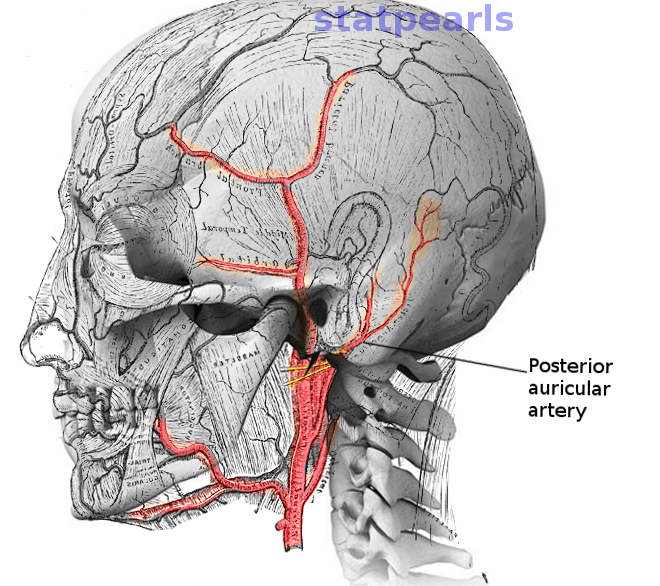[1]
Zilinsky I, Erdmann D, Weissman O, Hammer N, Sora MC, Schenck TL, Cotofana S. Reevaluation of the arterial blood supply of the auricle. Journal of anatomy. 2017 Feb:230(2):315-324. doi: 10.1111/joa.12550. Epub 2016 Oct 11
[PubMed PMID: 27726131]
[2]
Liu M, Wang SJ, Benet A, Meybodi AT, Tabani H, Ei-Sayed IH. Posterior auricular artery as a novel anatomic landmark for identification of the facial nerve: A cadaveric study. Head & neck. 2018 Jul:40(7):1461-1465. doi: 10.1002/hed.25127. Epub 2018 Mar 22
[PubMed PMID: 29566447]
[3]
Upile T, Jerjes W, Nouraei SA, Singh SU, Kafas P, Sandison A, Sudhoff H, Hopper C. The stylomastoid artery as an anatomical landmark to the facial nerve during parotid surgery: a clinico-anatomic study. World journal of surgical oncology. 2009 Sep 28:7():71. doi: 10.1186/1477-7819-7-71. Epub 2009 Sep 28
[PubMed PMID: 19785731]
[4]
Pan WR, le Roux CM, Levy SM, Briggs CA. Lymphatic drainage of the external ear. Head & neck. 2011 Jan:33(1):60-4. doi: 10.1002/hed.21395. Epub
[PubMed PMID: 20848416]
[5]
Tokugawa J, Cho N, Suzuki H, Sugiyama N, Akiyama O, Nakao Y, Yamamoto T. Novel classification of the posterior auricular artery based on angiographical appearance. PloS one. 2015:10(6):e0128723. doi: 10.1371/journal.pone.0128723. Epub 2015 Jun 1
[PubMed PMID: 26030595]
[6]
Kobayashi S, Nagase T, Ohmori K. Colour Doppler flow imaging of postauricular arteries and veins. British journal of plastic surgery. 1997 Apr:50(3):172-5
[PubMed PMID: 9176003]
[7]
Torazawa S, Hasegawa H, Kin T, Sato H, Sora S. Long-Term Patency of Posterior Auricular Artery-Middle Cerebral Artery Bypass for Adult-Onset Moyamoya Disease: Case Report and Review of Literature. World neurosurgery. 2017 Dec:108():994.e1-994.e5. doi: 10.1016/j.wneu.2017.09.005. Epub 2017 Sep 20
[PubMed PMID: 28939540]
Level 3 (low-level) evidence
[8]
Tokugawa J, Nakao Y, Kudo K, Iimura K, Esaki T, Yamamoto T, Mori K. Posterior auricular artery-middle cerebral artery bypass: a rare superficial temporal artery variant with well-developed posterior auricular artery-case report. Neurologia medico-chirurgica. 2014:54(10):841-4
[PubMed PMID: 24140773]
Level 3 (low-level) evidence
[9]
Oufkir AA, Kajout M, Chadli R, Alami MN. [Comments on article "Scalp flap pedicled on posterior auricular artery. Anatomical study and clinical application"]. Annales de chirurgie plastique et esthetique. 2015 Jun:60(3):252-3. doi: 10.1016/j.anplas.2015.03.002. Epub 2015 Apr 1
[PubMed PMID: 25841768]
Level 3 (low-level) evidence
[10]
Caughlin BP, Redleaf M. Posterior auricular artery fasciocutaneous island flap: lateral temporal soft tissue reconstruction. The Laryngoscope. 2016 Mar:126(3):722-6. doi: 10.1002/lary.25499. Epub 2015 Jul 30
[PubMed PMID: 26228008]
[11]
Zhang YZ, Li YL, Yang C, Fang S, Fan H, Xing X. Reconstruction of the postauricular defects using retroauricular artery perforator-based island flaps: Anatomical study and clinical report. Medicine. 2016 Sep:95(37):e4853. doi: 10.1097/MD.0000000000004853. Epub
[PubMed PMID: 27631246]
[12]
Hénoux M, Espitalier F, Hamel A, Dréno B, Michel G, Malard O. Vascular Supply of the Auricle: Anatomical Study and Applications to External Ear Reconstruction. Dermatologic surgery : official publication for American Society for Dermatologic Surgery [et al.]. 2017 Jan:43(1):87-97. doi: 10.1097/DSS.0000000000000928. Epub
[PubMed PMID: 28027200]
[13]
Gómez Díaz OJ, Cruz Sánchez MD. Anatomical and Clinical Study of the Posterior Auricular Artery Angiosome: In Search of a Rescue Tool for Ear Reconstruction. Plastic and reconstructive surgery. Global open. 2016 Dec:4(12):e1165. doi: 10.1097/GOX.0000000000001165. Epub 2016 Dec 27
[PubMed PMID: 28293515]
[14]
Elvan Ö, Bobuş A, Erdoğan S, Aktekin M, Olgunus ZK. Fetal anatomy of the facial nerve trunk and its relationship with posterior auricular artery. Surgical and radiologic anatomy : SRA. 2019 Feb:41(2):153-159. doi: 10.1007/s00276-018-2126-x. Epub 2018 Oct 26
[PubMed PMID: 30367188]

